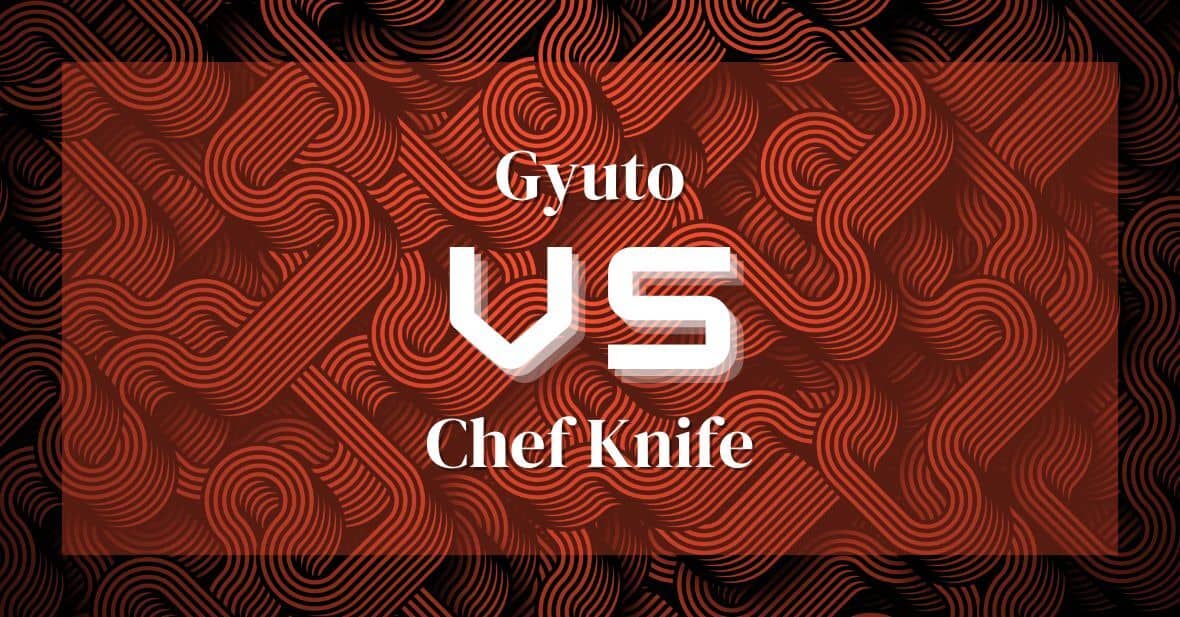Gyuto vs Chef Knife: Discovering the Japanese Blade for Every Chef
You may think that a gyuto and a chef knife are the same thing. In reality, though, there’s actually quite a bit of difference between them!
Sure, they may look similar at first glance, but don’t be fooled – these knives have some distinct differences.
From blade length to handle design and weight balance to edge retention, here’s your complete guide to understanding the distinct differences between the gyuto and chef knife.
So if you’ve ever been confused about which one is best for you—it’s time to find out!
Blade Length
You may be wondering what the difference is when it comes to blade length – let’s explore that now!
A Gyuto knife features a longer blade than a chef knife; typically between 210 and 270 millimeters long. With its extra length, you can easily chop vegetables or slice through large cuts of meat with ease.
The sharpness comparison is also important to consider: Gyuto knives, being a Japanese type of knife are made from higher quality steel, which makes them sharper and better at retaining their edge than chef knives. If you’re looking for superior performance, the Gyuto definitely has the edge here.
When it comes down to it, both types of knives offer advantages and disadvantages depending on your needs. But if you want ultimate precision, then the longer, sharper Gyuto is probably your best bet.
Blade Shape
You’ll find that a gyuto has a thinner blade than other types of knives, with an average blade thickness of around 2.5mm – making it almost twice as thin as the average chef knife.
The shape of the blade is quite different too! While some chef knives have a curved edge, a gyuto typically has two flat sides, which are then ground to two different angles – also known as an asymmetric bevel. This allows for more control when slicing and chopping food.
Plus, you can choose from various steel types depending on your budget and preferences. Here’s a list of what to consider when choosing between the two:
- Grinding angles – A gyuto usually has two flat sides that are grinded at different angles for better control when cutting or chopping
- Steel types – You can opt for various steel types depending on your budget and needs
- Blade length – Gyutos tend to have shorter blades than chef knives, so be sure to pick one based on the tasks you plan to do with it!
Handle Design
When it comes to handle design, you’ll find that a gyuto typically has a more ergonomic shape than other types of knives, making it easier and more comfortable to use. The handle is designed with comfort in mind, so you can work for longer periods without feeling fatigued.
Plus, the grinding angles are usually sharper than those found on chef knives, allowing for better control when cutting. And if you’re looking for something extra special, some gyutos come with high-quality handle materials that provide superior durability and strength.
So, whether you’re slicing vegetables or carving meat, the right handle design will make all the difference in your cooking experience!
Weight and Balance
Feeling the weight and balance of a knife in your hand can make all the difference when it comes to cooking, giving you confidence and control with every cut. When comparing a Gyuto vs Chef Knife, there are several factors to consider:
- The sharpness of the blade – both knives have incredibly sharp blades that’ll make slicing through ingredients effortless.
- The price – Gyutos tend to be more expensive than Chef Knives due to their higher quality materials.
- The weight and balance – Gyutos are usually heavier than Chef Knives, making them better suited for tougher tasks like chopping vegetables or cutting through meat. However, they may not be as comfortable for smaller hands or those who prefer lighter knives.
- The handle design – both knives feature ergonomic handles that provide comfort and stability while using them.
- The length of the blade – Gyutos typically have longer blades than Chef Knives, which makes them great for larger tasks such as slicing large cuts of meat or chopping vegetables into small pieces.
When it comes down to it, choosing between a Gyuto vs Chef Knife is really about personal preference and what works best for you in the kitchen!
Edge Retention
Edge retention is an important factor to consider when selecting a kitchen knife, as it determines how long the blade will stay sharp. For example, some knives are made with harder steel that can retain its edge for longer periods of time, while others may require more frequent sharpening.
When comparing gyuto and chef knives in terms of edge retention, it’s important to note that the former typically has better sharpness and requires less maintenance than the latter. This means that you won’t have to sharpen your gyuto as often as you would a chef knife, making it a great choice if you’re looking for something that will stay sharper for longer.
Frequently Asked Questions
What is the best way to sharpen a Gyuto or chef knife?
Sharpening your knife doesn’t have to be an intimidating task! With the right tools and a bit of practice, you’ll be slicing and dicing with ease.
To get the job done, you’ll want to grab yourself some sharpening stones or honing rods. Sharpening stones are great for restoring your blade’s edge while honing rods help maintain its sharpness.
Start by running your blade along the stone in one direction until it’s as sharp as you’d like it. Remember to always sharpen away from yourself and keep a steady pressure on the blade.
If you’re using a honing rod, pull the knife through in one direction with gentle strokes instead of pushing down hard on it.
Before long, you’ll have a razor-sharp knife that can handle anything!
What is the difference between a Gyuto and a chef knife?
Do you know the difference between a gyuto and a chef knife? Well, if you don’t, it’s time to learn!
You see, while they may look similar at first glance, there are some key differences that set them apart when it comes to caring for the blade and understanding their respective knife design features.
Gyutos are often described as having a longer blade than its chef knife cousin and also feature a slightly more curved cutting edge. This makes them great for slicing and chopping through tough ingredients like meat or vegetables.
On the other hand, chef knives have shorter blades with straighter edges which make them ideal for mincing and dicing.
So next time you’re in the market for either one of these kitchen staples, remember – gyutos carve while chefs mince!
What is the best material for a Gyuto or chef knife blade?
When it comes to choosing the best material for a chef or gyuto knife blade, you can’t go wrong with either Damascus steel or Carbon steel.
The two materials offer different levels of strength and durability, so it’s important to decide which is right for you.
Damascus steel offers a unique pattern that looks good in any kitchen, while Carbon steel provides ultimate sharpness and edge retention.
Whichever one you choose, there’s no doubt that your kitchen arsenal will be improved!
What is the best handle design for a Gyuto or chef knife?
When it comes to handle design, a great chef knife is like a trusty sidekick: it should have a balanced weight and ergonomic grip that feels just right in your hands. Imagine the perfect combination of comfort and strength like two puzzle pieces fitting together perfectly.
Whether you’re dicing onions or creating intricate garnishes, having a handle that feels good in your hand can make all the difference.
The most important part of finding the best handle design for you is to experiment with different shapes and materials until you find what works best for your cooking style – it’s almost like discovering the perfect dance partner!
What is the best way to store a Gyuto or chef knife?
Storing your kitchen knives correctly is essential for keeping them in top shape. You should always remember to practice proper knife maintenance and blade care.
The best way to store a knife is using a knife block, magnetic strip, or wall mount rack. These options keep your blades away from other objects that could damage the edge of the blade. Additionally, they make it easy to access the knife when you’re ready to use it. Plus, they look really cool!
Keep in mind, if you choose a magnetic strip or wall mount rack, make sure your knives are stored with their handles facing up. This will prevent them from accidentally falling off.
Conclusion
You’ve seen the major differences between a gyuto and a chef’s knife, so it’s time to make your decision. If you want an all-purpose blade that can handle both chopping and slicing, the gyuto is for you. Its longer blade length and curved shape give it more versatility than the average chef’s knife.
Plus, its lightweight design and comfortable handle make it easy to maneuver with precision. On the other hand, if edge retention is important to you then go with the chef’s knife – its thick spine gives it superior durability in comparison.
Ultimately though, only you can decide which one fits your cooking style best – whether from this decade or any other!

